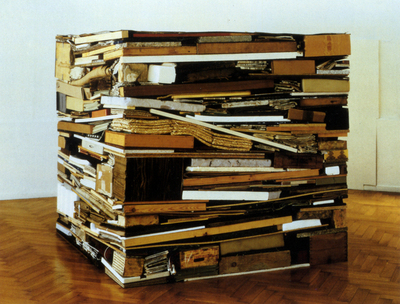To gather together; assemble.
To accumulate; make a collection of.
To regain control of (oneself or one's thoughts, faculties, composure, or the like).
05/09/2012- Tony Cragg (Man-made objects, stacking, rubbish and recycling)
'Tony Cragg made sculptures in the late 1970s and early 1980s that tended to be constructed from an assortment of smaller objects. Stack (1975), for example, is a cube made up of a variety of materials, both synthetic and natural, ranging from traditional materials, such as wood, to the unusual, including plastic bottles. The objects are arranged into strata as if part of a geological formation. Given its mixture of the natural and the artificial, Stack seems to have invited reflection on the relationship between the two, at a time when environmental worries were beginning to register.

Stack, 1975

Black and White Stack, 1980
In Britain Seen from the North (1981), the artist uses a similar technique, this time to create an image of Britain on its side, with a man (Cragg himself) viewing it from the north. Cragg was living in Germany by this time, and was viewing his country through the eyes of an outsider. Britain Seen from the North is comprised of a number of man-made objects and fragments gathered in the country, and is literally constructed from products of Britain. More pointedly though, it is constructed from Britain's waste. This junk aesthetic seems fitting for the economic slump of the early 1980s, and implies links between industry, consumption and the wider picture of the national economy.
Both of these works are absolutely reliant on the relationship between the whole and its constituent parts, a sculptural technique that forces viewers to make connections between national politics and everyday life. Cragg therefore belongs within a history of modern artists who draw broad political statements from the debris of the commonplace.' (The Contemporary Art Book, Charlotte Bonham- Carter and David Hodge)

Britain Seen from the North, 1981
08/03/2012
A few days ago i watched a channel 4 documentary called 'Obsessive Compulsive Hoarder', which describes the disorderly life of Richard Wallis, who lives in a hoarding mental state. His objective in life is to construct and maintain an archive of magazines, newspapers and packaging, with a rusting collection of classic cars in his back garden also, his house literally filled to the brim of 34 years worth of collecting and never throwing anything away.
He never married, he has no children and no family for support and has become somewhat a recluse, living on just two boiled eggs a day. He descibes his life as not a 'life'- but just an 'existence'.


Whilst watching this, i thought of my art practice in a new light, if im composing art with a similar theme to this at the moment, will i ever get this bad later on in life? I think its safe to say i won't, my habits of collecting, ordering, repeating etc. are, although slightly obsessive at the moment, controllable.
05/09/2012- Tony Cragg (Man-made objects, stacking, rubbish and recycling)
'Tony Cragg made sculptures in the late 1970s and early 1980s that tended to be constructed from an assortment of smaller objects. Stack (1975), for example, is a cube made up of a variety of materials, both synthetic and natural, ranging from traditional materials, such as wood, to the unusual, including plastic bottles. The objects are arranged into strata as if part of a geological formation. Given its mixture of the natural and the artificial, Stack seems to have invited reflection on the relationship between the two, at a time when environmental worries were beginning to register.

Stack, 1975

Black and White Stack, 1980
In Britain Seen from the North (1981), the artist uses a similar technique, this time to create an image of Britain on its side, with a man (Cragg himself) viewing it from the north. Cragg was living in Germany by this time, and was viewing his country through the eyes of an outsider. Britain Seen from the North is comprised of a number of man-made objects and fragments gathered in the country, and is literally constructed from products of Britain. More pointedly though, it is constructed from Britain's waste. This junk aesthetic seems fitting for the economic slump of the early 1980s, and implies links between industry, consumption and the wider picture of the national economy.
Both of these works are absolutely reliant on the relationship between the whole and its constituent parts, a sculptural technique that forces viewers to make connections between national politics and everyday life. Cragg therefore belongs within a history of modern artists who draw broad political statements from the debris of the commonplace.' (The Contemporary Art Book, Charlotte Bonham- Carter and David Hodge)

Britain Seen from the North, 1981
08/03/2012
A few days ago i watched a channel 4 documentary called 'Obsessive Compulsive Hoarder', which describes the disorderly life of Richard Wallis, who lives in a hoarding mental state. His objective in life is to construct and maintain an archive of magazines, newspapers and packaging, with a rusting collection of classic cars in his back garden also, his house literally filled to the brim of 34 years worth of collecting and never throwing anything away.
He never married, he has no children and no family for support and has become somewhat a recluse, living on just two boiled eggs a day. He descibes his life as not a 'life'- but just an 'existence'.


Whilst watching this, i thought of my art practice in a new light, if im composing art with a similar theme to this at the moment, will i ever get this bad later on in life? I think its safe to say i won't, my habits of collecting, ordering, repeating etc. are, although slightly obsessive at the moment, controllable.